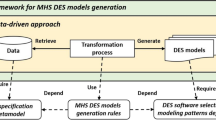Abstract
Whereas in the past the sustainable use of resources and the reduction of waste have mainly been looked at from an ecological point of view, resource efficiency recently becomes more and more an issue of cost saving as well. Before resource consumption in manufacturing processes can be reduced systematically it is necessary to quantify the amount of resources needed, to identify major consumers and to determine the available degrees of freedom for a reduction. Simulation can be an adequate tool; however, most of the available simulation methods are not suitable for this task. Therefore in close cooperation of production engineering and computer science a new method is being developed to quantify and numerically optimize the resource consumption of manufacturing process chains. In particular, the resources electrical energy, raw material, cooling lubricants and tool wear are taken into consideration. The concept will be demonstrated exemplary in this paper for the consumption of electrical energy.
A new, system theoretical approach, the System Entity Structure framework (SES) is utilized to define alternative manufacturing sequences and parameter sets independently of a specific manufacturing task in a meta-model. Furthermore, a model base is used as a library to store specific models for each relevant manufacturing process. The concept of the so-called basis models is based on the discrete-event simulation. It has been adapted to model machining procedures and to generate workpiece-specific resource consumption profiles and footprints.
A search and optimization algorithm is able to examine valid combinations of manufacturing processes and parameter sets in the meta-model for user-specific manufacturing tasks. The optimization result is a parameter and structure optimal model of the process chain which is transferable to the real planning task.
Access this chapter
Tax calculation will be finalised at checkout
Purchases are for personal use only
Similar content being viewed by others
References
Müller E, Engelmann J, Strauch J (2008) Energieeffizienz als Zielgröße in der Fabrikplanung. wt Werkstattstechnik online 7/8
Neugebauer R (2008) Energieeffizienz in der Produktion, Untersuchung zum Handlungs- und Forschungsbedarf
O. Hagendorf (2009) Simulation Based Parameter and Structure Optimisation of Discrete Event Systems. PhD thesis, Liverpool John Moores University
J.R. Swisher, and P.D. Hyden (2000) A Survey of Simulation Optimization Techniques and Procedures. Proceedings of the 2000 Winter Simulation Conference
J.W. Rozenblit, and B.P. Zeigler (1985) Concepts for Knowledge-Based System Design Environments. Proceedings of the 1985 Winter Simulation Conference
B.P. Zeigler, and H. Praehofer, and T. G. Kim (2000) Theory of Modeling and Simulation. Academic Press
G. Zhang, B.P. Zeigler (1989) The system Entity Structure: Knowledge Representation for Simulation Modeling and Design. Artificial Intelligence, Simulation, and Modeling, Widman L.E., Loparo K.A., Nielsen N.R. (Ed.), John Wiley & Sons Inc
Kuhrke B (2009) Ansätze zur Optimierung und Bewertung des Energieverbrauchs von Werkzeugmaschinen. Proc. of “Die energieeffiziente Werkzeugmaschine” Düsseldorf
Brinksmeier, E., Walter, A., Eckebrecht, J., Heinzel, C. (1996) Umweltverträgliche Fertigungsprozesse: Ganzheitliche Konzepte sind gefragt, Industrie Management 12, S. 9–12
Acknowledgements
The interdisciplinary research in this project is funded by the German Research Foundation DFG.
Author information
Authors and Affiliations
Corresponding author
Editor information
Editors and Affiliations
Rights and permissions
Copyright information
© 2013 Springer-Verlag Berlin Heidelberg
About this paper
Cite this paper
Larek, R., Brinksmeier, E., Pawletta, T., Hagendorf, O. (2013). Model-Based Planning of Resource Efficient Process Chains Using System Entity Structures. In: Schuh, G., Neugebauer, R., Uhlmann, E. (eds) Future Trends in Production Engineering. Springer, Berlin, Heidelberg. https://doi.org/10.1007/978-3-642-24491-9_36
Download citation
DOI: https://doi.org/10.1007/978-3-642-24491-9_36
Published:
Publisher Name: Springer, Berlin, Heidelberg
Print ISBN: 978-3-642-24490-2
Online ISBN: 978-3-642-24491-9
eBook Packages: EngineeringEngineering (R0)




